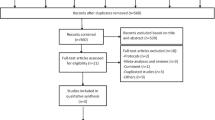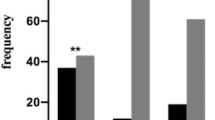Abstract
Depression is a common emotional disorder associated with increased risk of suicide and rate of disability. In this double-blinded control study, we tested the efficacy of modified electroconvulsive therapy (MECT) in patients with treatment resistant depression (TRD) using the Hamilton Depression Rating Scale for Depression (HAMD). The total scores of HAMD were found to be significantly decreased after the treatment. The genotyping of catechol-O-methyltransferase (COMT) was carried out with polymerase chain reaction-based testing. Our results demonstrated that frequency of mutant COMT alleles in TRD patients was significantly higher than that of the controls indicating a correlation of the enzyme genotype to the occurrence of TRD. Moreover, the patients homozygous for wild-type COMT gene (G/G) were evidenced to be more sensitive to MECT treatment than those with an heterozygous mutant genotype (A/G).


Similar content being viewed by others
References
Alladin, A. (2012). Cognitive hypnotherapy for major depressive disorder. American Journal of Clinical Hypnosis, 54(4), 275–293.
Covvey, J. R., Crawford, A. N., & Lowe, D. K. (2012). Intravenous ketamine for treatment-resistant major depressive disorder. Annals of Pharmacotherapy, 46(1), 117–123.
Kupfer, D. J., Frank, E., & Phillips, M. L. (2012). Major depressive disorder: new clinical, neurobiological, and treatment perspectives. Lancet, 379(9820), 1045–1055.
Vohringer, P. A., & Ghaemi, S. N. (2011). Solving the antidepressant efficacy question: Effect sizes in major depressive disorder. Clinical Therapeutics, 33(12), B49–B61.
Bailey, R. K., et al. (2011). Major depressive disorder in the African American population. Journal of the National Medical Association, 103(7), 548–557.
Trivedi, M. H., et al. (2006). Evaluation of outcomes with citalopram for depression using measurement-based care in STAR*D: implications for clinical practice. American Journal of Psychiatry, 163(1), 28–40.
Breese McCoy, S. J. (2011). Postpartum depression: an essential overview for the practitioner. Southern Medical Journal, 104(2), 128–132.
Massat, I., et al. (2005). Association between COMT (Val158Met) functional polymorphism and early onset in patients with major depressive disorder in a European multicenter genetic association study. Molecular psychiatry, 10(6), 598–605.
Morgan, M. L., et al. (2005). Estrogen augmentation of antidepressants in perimenopausal depression: a pilot study. Journal of Clinical Psychiatry, 66(6), 774–780.
Crown, W. H., et al. (2002). The impact of treatment-resistant depression on health care utilization and costs. Journal of Clinical Psychiatry, 63(11), 963–971.
Nemeroff, C. B. (2007). Prevalence and management of treatment-resistant depression. Journal of Clinical Psychiatry, 68(Suppl 8), 17–25.
Karasu, T. B., et al. (2000). Practice guideline for the treatment of patients with major depressive disorder (revision). American Psychiatric Association. American Journal of Psychiatry, 157(4), 1–45.
UK ECT Review Group. (2003). Efficacy and safety of electroconvulsive therapy in depressive disorders: a systematic review and meta-analysis. Lancet, 361(9360), 799–808.
Folkerts, H. W., et al. (1997). Electroconvulsive therapy vs. paroxetine in treatment-resistant depression—a randomized study. Acta Psychiatrica Scand, 96(5), 334–342.
Kho, K. H., et al. (2003). A meta-analysis of electroconvulsive therapy efficacy in depression. The journal of ECT, 19(3), 139–147.
Caspi, A., et al. (2003). Influence of life stress on depression: moderation by a polymorphism in the 5-HTT gene. Science, 301(5631), 386–389.
Mandelli, L., et al. (2007). Interaction between serotonin transporter gene, catechol-O-methyltransferase gene and stressful life events in mood disorders. International Journal of Neuropsychopharmacology, 10(4), 437–447.
Numata, S., et al. (2007). Interaction between catechol-O-methyltransferase (COMT) Val108/158Met and brain-derived neurotrophic factor (BDNF) Val66Met polymorphisms in age at onset and clinical symptoms in schizophrenia. Journal of Neural Transmission, 114(2), 255–259.
Honea, R., et al. (2009). Impact of interacting functional variants in COMT on regional gray matter volume in human brain. Neuroimage, 45(1), 44–51.
Congdon, E., et al. (2009). Influence of SLC6A3 and COMT variation on neural activation during response inhibition. Biological Psychology, 81(3), 144–152.
Kunugi, H., et al. (1997). No evidence for an association of affective disorders with high- or low-activity allele of catechol-o-methyltransferase gene. Biological Psychiatry, 42(4), 282–285.
Bertolino, A., et al. (2004). Interaction of COMT (Val(108/158)Met) genotype and olanzapine treatment on prefrontal cortical function in patients with schizophrenia. American Journal of Psychiatry, 161(10), 1798–1805.
Heyer, N. J., et al. (2009). Catechol O-methyltransferase (COMT) VAL158MET functional polymorphism, dental mercury exposure, and self-reported symptoms and mood. Journal of Toxicology and Environmental Health, Part A, 72(9), 599–609.
Woodward, N. D., Jayathilake, K., & Meltzer, H. Y. (2007). COMT val108/158met genotype, cognitive function, and cognitive improvement with clozapine in schizophrenia. Schizophrenia Research, 90(1–3), 86–96.
Gupta, M., et al. (2009). Association studies of catechol-O-methyltransferase (COMT) gene with schizophrenia and response to antipsychotic treatment. Pharmacogenomics, 10(3), 385–397.
Dai, Y., et al. (2014). Comparison of Chinese and international psychiatrists’ views on classification of mental disorders. Asia-Pacific Psychiatry, 6(3), 267–273.
Yasuda, K., Kobayashi, K., Yamaguchi, M., et al. (2014). Seizure threshold and the half-age method in bilateral electroconvulsive therapy in Japanese patients. Psychiatry and Clinical Neurosciences. doi:10.1111/pcn.12225.
Young, E., & Korszun, A. (1998). Psychoneuroendocrinology of depression. Hypothalamic-pituitary-gonadal axis. Psychiatric Clinics of North America, 21(2), 309–323.
Deng, A. W., et al. (2014). Prevalence and risk factors of postpartum depression in a population-based sample of women in Tangxia Community, Guangzhou. Asian Pacific Journal of Tropical Medicine, 7(3), 244–249.
Fantoni, A., et al. (1977). Association of adult obese-type diabetes and depressive psychosis (clinical cases). Annali dell’Ospedale Maria Vittoria di Torino, 20(1–6), 51–67.
Stamm, T. J., et al. (2013). Depression with psychotic features is influenced by the polymorphism of the serotonin transporter gene. Journal of Affective Disorders, 151(2), 605–610.
Tang, H., et al. (2014). Combination of sacral neuromodulation and tolterodine for treatment of idiopathic overactive bladder in women: a clinical trial. Urology Journal, 11(4), 1800–1805.
Zhu, B. T. (2002). Catechol-O-Methyltransferase (COMT)-mediated methylation metabolism of endogenous bioactive catechols and modulation by endobiotics and xenobiotics: importance in pathophysiology and pathogenesis. Current Drug Metabolism, 3(3), 321–349.
Lachman, H. M., Papolos, D. F., Saito, T., et al. (1996). Human catechol-Omethyltransferase pharmacogenetics: Description of a functional polymorphism and its potential application to neuropsychiatric disorders. Pharmacogenetics, 6, 243–250.
Weinshilboum, R. M., Otterness, D. M., Szumlanski, C. L., et al. (1999). Methylation pharmacogenetics: Catechol Omethyltransferase, thiopurine methyltransferase, and histamine N-methyltransferase. Annual Review of Pharmacology and Toxicology, 39, 19–52.
Stein, M. B., et al. (2005). COMT polymorphisms and anxiety-related personality traits. Neuropsychopharmacology, 30(11), 2092–2102.
Aguilera, M., et al. (2008). Putative role of the COMT gene polymorphism (Val158Met) on verbal working memory functioning in a healthy population. American Journal of Medical Genetics Part B: Neuropsychiatric Genetics, 147B(6), 898–902.
Author information
Authors and Affiliations
Corresponding author
Rights and permissions
About this article
Cite this article
Lin, Z., He, H., Zhang, C. et al. Influence of Val108/158Met COMT Gene Polymorphism on the Efficacy of Modified Electroconvulsive Therapy in Patients with Treatment Resistant Depression. Cell Biochem Biophys 71, 1387–1393 (2015). https://doi.org/10.1007/s12013-014-0361-2
Published:
Issue Date:
DOI: https://doi.org/10.1007/s12013-014-0361-2




